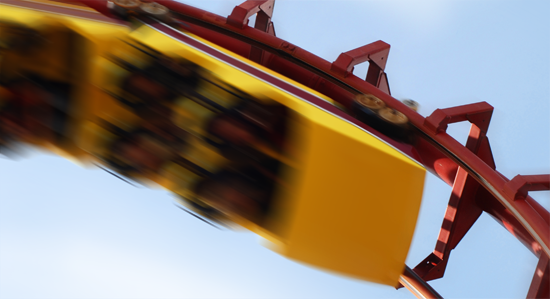
APRIL-MAY 2012
Rethinking
Outreach
Digital Edition
----------------------
History Resources
|

Calm Down and Enjoy the Ride
by John Brummitt
I have always enjoyed riding roller coasters.
It’s exciting to be strapped into a little bucket then slung up and down and around in circles, all at break-neck speeds. But it’s a short ride. If you have watched the news in the past year, you know that your investments have also been on a massive roller coaster without any real end in sight. How do we endure the ride without losing our lunch?
Watch for Warning Signs
Before strapping into any roller coaster, potential riders are bombarded with signs and warnings about what is required and prohibited—no pregnant women or people with heart problems or high blood pressure. You can’t miss the warnings.
When it comes to the market, however, many investors only see the first part of the ride, the uphill climb. They don’t bother to check out the rest of the ride or read the risks involved. The fact that the track for the financial roller coaster is being laid in front of us as we ride doesn’t allow for a lot of reaction time in our investments. So, where do we find warning signs? We check the past track record to make an educated guess about risks that lie ahead.
Follow Safety Instructions
Safety instructions for a roller coaster are pretty cut and dry: keep hands and feet inside the ride at all times; don’t remove safety restraints; and remain seated until the ride comes to a complete stop. Safe investments are a little more difficult to nail down because the ride lasts far longer than a minute or two. When we know the ride will last 40 years or more, we are more jumpy about staying put, even though it usually works to our advantage to do so.
In a report by Fidelity Investments, participants in retirement plans who dropped their equity (stock) allocation to zero between October 1, 2008, and March 31, 2009, and kept it there saw their accounts grow two percent on average through June 30, 2011. In contrast, investors who returned to equities at some point saw their balance jump 25%. And those who remained seated throughout the ride saw their balance increase by 50%.
Exit to the Right Plan
Eventually, everyone must exit the investment ride. Remember to gather your belongings before you exit. On a roller coaster, everyone gets off at the same time. You can’t miss the sudden stop as the brakes lock in at the end of the ride, everyone is slung against their restraints, and the cars come to a screeching stop.
With retirement it’s a little different. It’s more like switching tracks for your cart. This can be a tricky process but can be done easily if you plan well and follow several simple guidelines. Never switch tracks while you are on a downhill grade because the cart is traveling too fast to make the switch without suffering any damage. Plan for the transition as a year rather than a day. This will allow you to slow down and switch tracks without turning over your cart at breakneck speed. Those retiring in 2012 should have been making adjustments in 2010 or even earlier.
While roller coasters can be frightening, they can also be a lot of fun. Just remember to watch for the warnings, remember the safety instructions, and start planning your exit strategy years before you actually reach the end of the ride. Jumping off a roller coaster in motion is never a good idea.
About the Writer: A 2011 MBA/Finance graduate from Tennessee Technological University, John Brummitt is chief financial officer for the FWB Board of Retirement.
|
|

